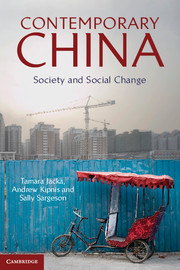Book contents
- Frontmatter
- Contents
- List of Images
- List of Maps
- List of Figures
- List of Tables
- Acknowledgments
- List of Abbreviations
- Map 0.1: China's provinces and provincial capitals
- Introduction
- Part 1 Social Institutions
- Part 2 Cultures, Socialization and the Formation of Identities
- 6 Religion, Ritual and Religiosity
- 7 Ethnicity
- 8 Education and the Cultivation of Citizens
- 9 Modernity, Youth Identities and Popular Culture
- Part 3 Inequalities, Injustices and Social Responses
- Glossary of Chinese Terms
- References
- Index
8 - Education and the Cultivation of Citizens
Published online by Cambridge University Press: 05 June 2014
- Frontmatter
- Contents
- List of Images
- List of Maps
- List of Figures
- List of Tables
- Acknowledgments
- List of Abbreviations
- Map 0.1: China's provinces and provincial capitals
- Introduction
- Part 1 Social Institutions
- Part 2 Cultures, Socialization and the Formation of Identities
- 6 Religion, Ritual and Religiosity
- 7 Ethnicity
- 8 Education and the Cultivation of Citizens
- 9 Modernity, Youth Identities and Popular Culture
- Part 3 Inequalities, Injustices and Social Responses
- Glossary of Chinese Terms
- References
- Index
Summary
Competition in China's education system is intense. The causes and consequences of this competition are complex and involve social stratification, gender and ethnic relations, economic inequality, political legitimacy, international migration and ideologies of development. In this chapter, we introduce the education system in China and assess the factors that contribute to its intensity and the consequences of intense educational competition for Chinese society. We also discuss state and popular discourses that promise the salvation of the Chinese nation through the cultivation of citizens. These discourses feed on, and contribute to, popular desires for educational success.
Educational structures in China
In China, it is compulsory to complete nine years of education (usually six years of primary school and three years of junior secondary school). Across most of the country, these nine years of education are now available for free to all citizens. This level of educational provision is an accomplishment that was gradually achieved over the course of most of the 20th century. It has only recently been attained in many rural areas. Because local governments have provided a good percentage of the funds for education, impoverished localities have been the last to be able to provide nine years of education for everybody. Recent efforts to increase the level of central and provincial funding for education in impoverished areas have been important to this success, as has the central state's requirement, as of 2006, that rural primary and junior secondary schools remove all tuition fees.
- Type
- Chapter
- Information
- Contemporary ChinaSociety and Social Change, pp. 161 - 178Publisher: Cambridge University PressPrint publication year: 2013
- 1
- Cited by

